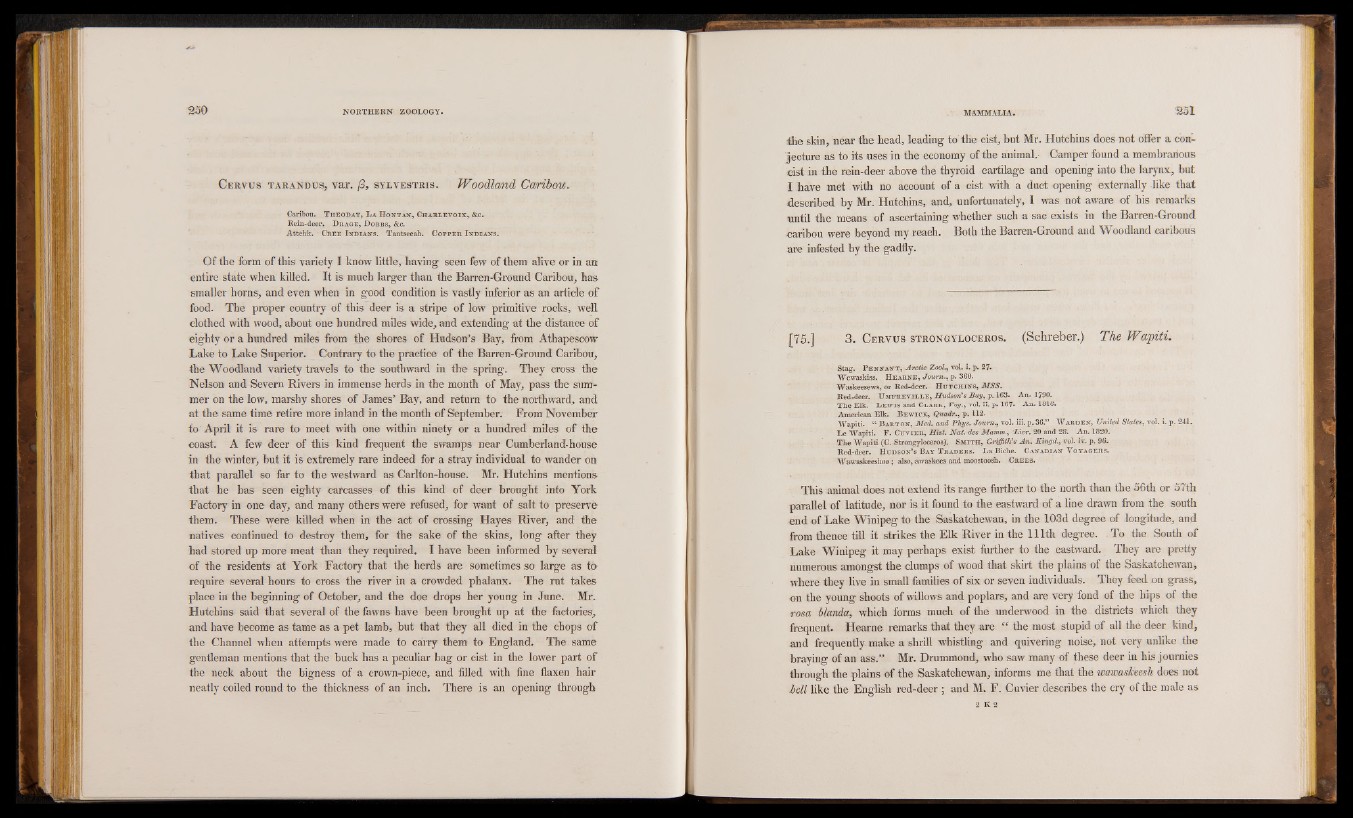
Cervus tarandus, var. /3, sylvestris. Woodland Caribou.
C a r ib o u . T h e o d a t , L a H o n t a n , C h a r l e v o ix , &c.
Rein-deer. D r a g e , D o b b s , &c.
A tt e h k . C r e e I n d ia n s . T a n ts e e a h . C o p p e r I n d ia n ’s .
Of the form of this variety I know little* having seen few of them alive or in an
entire state when killed. It is much larger than the Barren-Ground Caribou* has
smaller horns, and even when in good condition is vastly inferior as an article of
food. The proper country of this deer is a stripe of low primitive rocks, well
clothed with wood, about one hundred miles wide, and extending at the distance of
eighty or a hundred miles from the shores of Hudson’s Bay, from Athapescow
Lake to Lake Superior. Contrary to the practice of the Barren-Ground Caribou,
the Woodland variety travels to the southward in the spring. They cross the
Nelson and Severn Rivers in immense herds in the month of May, pass the summer
on the low, marshy shores of James’ Bay, and return to the northward, and
at the same time retire more inland in the month of September. From November
to April it is rare to meet with one within ninety or a hundred miles of the
coast. A few deer of this kind frequent the swamps near Cumberland-house
in the winter, but it is extremely rare indeed for a stray individual to wander on
that parallel so far to the westward as Carlton-house. Mr. Hutchins mentions
that he has seen eighty carcasses; of this kind of deer brought into York
Factory in one day, and many others were refused, for want of salt to preserve
them. These were killed when in the act of crossing Hayes River, and the
natives continued to destroy them, for the sake of the skins, long after they
had stored up more meat than they required. I have been informed by several
of the residents at York Factory that the herds are sometimes so large as to
require several hours to cross the river in a crowded phalanx. The rut takes
place in the beginning of October, and the doe drops her young in June. Mr.
Hutchins said that several of the fawns have been brought up at the factories,
and have become as tame as a pet lamb, but that they all died in the chops of
the Channel when attempts were made to carry them to England. The same
gentleman mentions that the buck has a peculiar bag or cist in the lower part of
the neck about the bigness of a crown-piece, and filled with fine flaxen hair
neatly coiled round to the thickness of an inch. There is an opening through
the skin, near the head, leading to the cist, but Mr. Hutchins does not offer a conjecture
as to its uses in the economy of the animal. Camper found a membranous
cist in the rein-deer above the thyroid cartilage and opening into the larynx, but
I have met with no account of a cist with a duct opening externally like that
described by Mr. Hutchins, and, unfortunately, I was not aware of his remarks
until the means of ascertaining whether such a sac exists in the Barren-Ground
caribou were beyond my reach. Both the Barren-Ground and Woodland caribous
are infested by the gadfly.
£75.] 3. Cervus strongyloceros. (Schreber.) The Wapiti.
Stag. Pennant, Arctic Zool., vol. i. p. 27.
Wewaskiss. Hearne, Joum., p. 360.
Waskeesews, or Red-deer. Hutchins, MSS.
Red-deer. U m f r e v i l l e , Hudson’s Bag, p. 163. An. 1790.
The Elk. L e w is and Cl a r k , Voy., vol. il. p. 167* An. 1816.
American Elk. B e w ic k , Q u a d r ., p. 112.
Wapiti. “ Barton, Med. and Phys. Joum., vol. iii. p. 36.” Warden, United States, vol. i. p. 241.
Le Wapiti. F. CtrviER, Hist. Nat. des Mamm., 'Livr. 20 and 28. An. 1820.
The Wapiti (C. Strongyloceros). Smith, Griffith's Am. Kinyd,, vol. iv. p. 96-
Red-deer. Hudson’s Bay Traders. La Biche. Canadian Voyagers.
Wawaskeeshoo ; also, awaskees and moostoosh. Crees.
This animal does not extend its range further to the north than the 56th or 57th
parallel of latitude, nor is it found to the eastward of a line drawn from the south
end of Lake Winipeg to the Saskatchewan, in the 103d degree of longitude, and
from thence till it strikes the Elk River in the 111th degree. To the South of
Lake Winipeg it may perhaps exist further to the eastward. They are pretty
numerous amongst the clumps of wood that skirt the plains of the Saskatchewan,
where they live in small families of six or seven individuals. They feed on grass,
on the young shoots of willows and poplars, and are very fond of the hips of the
rosa blanda, which forms much of the underwood in the districts which they
frequent. Hearne remarks that they are “ the most stupid of all the deer kind,
and frequently make a shrill whistling and quivering noise, not very unlike the
braying of an ass.” Mr. Drummond, who saw many of these deer in his journies
through the plains of the Saskatchewan, informs me that the wawasteesh does not
hell like the English red-deer ; and M. F. Cuvier describes the cry of the male as
2 K 2